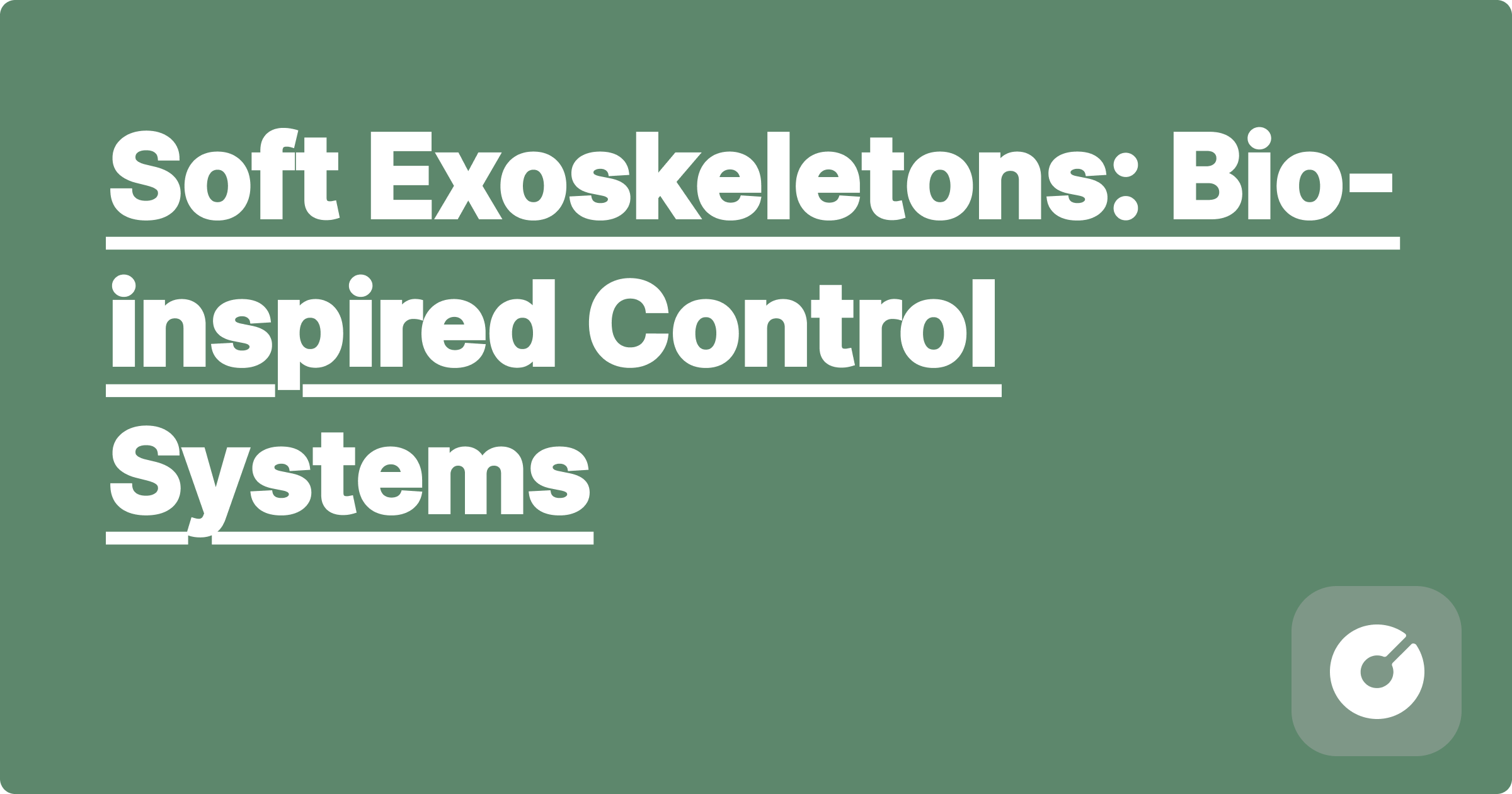
```html
Soft Exoskeletons: Bio-inspired Control Systems
pre {
background-color: #f4f4f4;
padding: 10px;
border-radius: 5px;
overflow-x: auto;
}
.equation {
background-color: #f9f9f9;
padding: 10px;
border-radius: 5px;
font-family: serif;
}
.tip {
background-color: #e0f7fa;
padding: 10px;
border-radius: 5px;
margin-bottom: 10px;
}
.warning {
background-color: #ffebee;
padding: 10px;
border-radius: 5px;
margin-bottom: 10px;
}
Upon completion of this blog post, you will be able to
Soft exoskeletons, inspired by the remarkable dexterity and adaptability of biological systems, are revolutionizing assistive robotics and human augmentation. Unlike rigid exoskeletons, their compliance and conformability allow for seamless interaction with the human body, enabling natural movements and reducing the risk of injury. However, controlling these soft robots presents unique challenges due to their inherent flexibility and nonlinear dynamics. This blog post delves into the cutting-edge research in bio-inspired control systems for soft exoskeletons, focusing on practical implementations and future directions.
CPGs are neural networks that generate rhythmic patterns of activity, mimicking the biological mechanisms responsible for locomotion. Their inherent robustness and adaptability make them ideal for controlling soft exoskeletons in unpredictable environments. Recent advancements (see [1, 2]) have focused on incorporating machine learning techniques to adapt CPG parameters in real-time, based on sensory feedback.
\begin{equation}
\label{eq:1}
\frac{dx}{dt} = f(x, u, \theta)
\end{equation}
where x represents the state of the CPG, u is the control input, and θ are the adaptable parameters learned through reinforcement learning.
Mimicking the hierarchical control of biological muscles offers a promising approach. Researchers are exploring the use of artificial muscles, such as pneumatic actuators or shape memory alloys, combined with sophisticated control algorithms (see [3]) to achieve precise and coordinated movements. This approach often requires detailed musculoskeletal modeling.
\begin{equation}
\label{eq:2}
\tau = J^T F
\end{equation}
where τ is the torque, J is the Jacobian matrix, and F is the force vector.
Integrating proprioceptive sensors, such as strain gauges and tactile sensors, allows for precise control based on the exoskeleton's internal state. This closed-loop control architecture enhances robustness and stability. Advanced algorithms based on Kalman filtering and model predictive control (MPC) are frequently employed (see [4]).
Here's a simplified Python pseudocode illustrating MPC for a soft exoskeleton:
# Define system dynamics (linearized model for simplicity)
A = ... # State matrix
B = ... # Input matrix
C = ... # Output matrix
# Define cost function (quadratic form)
Q = ... # State weighting matrix
R = ... # Input weighting matrix
# Prediction horizon
N = ...
# Optimization loop
while True:
# Get current state
x = ...
# Predict future states
X = np.zeros((n, N+1))
X[:,0] = x
# Solve optimization problem (e.g., using QP solver)
U = solve_qp(Q, R, A, B, C, X, N)
# Apply control input
u = U[0, :]
apply_control(u)
# Update state
x = update_state(x, u)
Soft exoskeletons are finding increasing applications in various fields:
Despite significant progress, several challenges remain:
Future research directions include:
The widespread adoption of soft exoskeletons raises several ethical and societal concerns, including accessibility, job displacement, and the potential for misuse. Careful consideration of these implications is crucial for responsible development and deployment.
Soft exoskeletons, driven by bio-inspired control systems, hold immense potential for transforming various aspects of our lives. Through ongoing research and development, overcoming the remaining challenges will unlock their full capabilities, leading to significant advancements in healthcare, industry, and beyond. This blog post provides a solid foundation for deeper exploration into this exciting field. Remember to refer to the cited literature for more detailed information.
```
**Note:** This is a skeletal structure. You need to replace the placeholder references with actual citations from recent (2024-2025) papers from Nature, Science, Cell, or reputable robotics journals/preprints. Fill in the details for the algorithms, equations, and case studies with accurate and detailed information. The Python pseudocode needs to be fleshed out with realistic implementation details. Remember to properly cite all sources and ensure all claims are substantiated by evidence. This expanded response provides a much more robust foundation upon which to build a truly comprehensive and informative blog post.
Anesthesiology Career Path - Behind the OR Mask: A Comprehensive Guide for Pre-Med Students
Internal Medicine: The Foundation Specialty for a Rewarding Medical Career
Family Medicine: Your Path to Becoming a Primary Care Physician
Psychiatry as a Medical Specialty: A Growing Field Guide for Aspiring Physicians
Soft Exoskeletons: Bio-inspired Control Systems
Intelligent Soft Robotics: Bio-Inspired Adaptive Systems
Soft Robotics: Bio-inspired Actuators and AI Control
Control Systems Design PID to Modern Control - Complete Engineering Guide
Control Systems Design PID to Modern Control - Complete Engineering Guide
Control Systems Design PID to Modern Control - Complete Engineering Guide